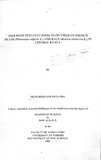| dc.description.abstract | The effects of pond effluent and its interaction with applied mineral fertilisers
was assessed in a field experiment with application of mineral fertilisers at
recommended rates and irrigation with pond effluent using french beans (Phaseolus
vulgaris L.) and kale (Brassica oleraceae) as test crops over two growing seasons.
Control treatments included unirrigated and unfertilised plots and irrigation with canal
water. The treatments were arran~ed as complete factorial and laid out in randomised
complete block design.
Plots receiving canal water and fertilisers at recommended rates had the highest
yields of 9.1 tonnes of fresh pod ha-1 while those receiving no fertilisers or irrigation
had the lowest yield of 1.3 tonnes fresh pod ha-1
• In the second season, significant
difference (P~O.05) were observed between treatments in fresh bean pod and fresh kale
leaf yield. The fresh pod yield was observed in pond effluent irrigated and fertilised
plots, while the lowest was observed in non irrigated not fertilised plots. The highest
fresh kale leaf yield of 11.5 tonnes ha-1 was obtained with irrigation with canal water
combined with fertiliser application, while the lowest yield of 4.2 tonnes ha-1 was
recorded from the non irrigated or fertilised plots. Economic return from kale were
significantly higher than from french beans due to a higher economic yield obtained
from kale.
In the second experiment, the effectiveness of two types of soil occurring at
Sagana, a Vertisol (black clay soil) and a Cambisol (red clay soil) in retaining nutrients
from pond effluents was investigated. A laboratory experiment was conducted with
soil columns containing red or black clay soil and 31, 81 and 161 mm day" effluent
xi
application intensities were tested on both soils. Both soils retained over 60% of total P
from pond effluents, with red clay soil retaining 27% more P than black clay soil. At
high effluent loading rate, low % N removal was observed in both soils. Total N
removal efficiency declined with time and after 21 days, no N removal was observed
where red clay soil was used. A significant difference (P~0.05) was observed in N
enrichment between soils. Black clay soil was more enriched by N more than red clay
soil, while P enrichment was higher in red clay soil than in black clay soil. This leads to
a conclusion that land application process of purifying pond effluents was more
effective in P removal but less in N removal. | en |

